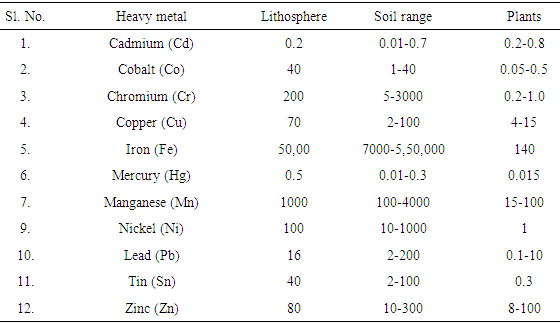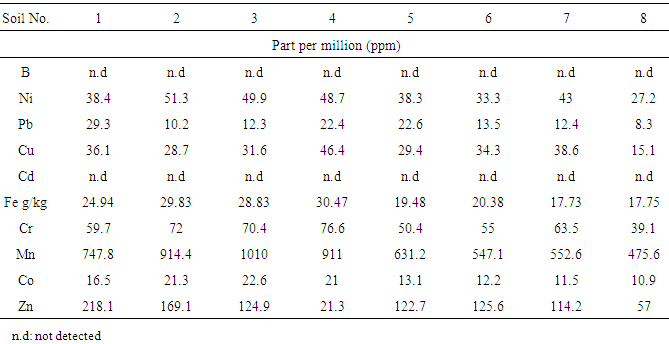-
Paper Information
- Paper Submission
-
Journal Information
- About This Journal
- Editorial Board
- Current Issue
- Archive
- Author Guidelines
- Contact Us
Resources and Environment
p-ISSN: 2163-2618 e-ISSN: 2163-2634
2016; 6(4): 72-79
doi:10.5923/j.re.20160604.02

The Impact of Gishouri Factories on Soil Pollution in Tulkarm Area: A Case Study
Basel Natsheh
Faculty of Agricultural Science and Technology, Palestine Technical University-Kadoorie, Tulkarm, Palestine
Correspondence to: Basel Natsheh, Faculty of Agricultural Science and Technology, Palestine Technical University-Kadoorie, Tulkarm, Palestine.
| Email: |  |
Copyright © 2016 Scientific & Academic Publishing. All Rights Reserved.
This work is licensed under the Creative Commons Attribution International License (CC BY).
http://creativecommons.org/licenses/by/4.0/

Gishori Industrial Complex is considered the most significant source of pollution in Tulkarm. Industrial by-products including gas, solid and liquid wastes are being released continuously in the region, affecting not only the health of more than 75000 people, but also agriculture and environment in the governorate. In recent years, several studies were conducted to highlight the impact of Gishori Industrial Complex. The aim of this work is to highlight and provide an indication of the negative environmental impact of Gishori Industrial Complex on Tulkarm city. This work represents an impact of Gishori Industrial Complex pollutants, such as heavy metals for example (B, Ni, Pb, Cu, Cd, Fe, Cr, Mn, Co and Zn) on soil. Eight soil samples were collected on July 3, 2015 from different sites within the target area to describe the effect of Gishori Industrial Complex on soil pollution. The results showed that the concentrations of these elements were higher than allowed in areas close to the factories. Pb, Ni and Zn were highly detected in soil samples (29.3, 51.3 and 218.1 p.p.m (part per million) per kilo gram, respectively). In conclusion the Gishori Industrial Complex have a negative impact on soil and environment. It is recommended to extend the study for taking into consideration the number of samples, the season of the year and the peak time during which the factories are in operation.
Keywords: Soil, Pollution, Tulkarm, Heavy metals
Cite this paper: Basel Natsheh, The Impact of Gishouri Factories on Soil Pollution in Tulkarm Area: A Case Study, Resources and Environment, Vol. 6 No. 4, 2016, pp. 72-79. doi: 10.5923/j.re.20160604.02.
Article Outline
1. Introduction
1.1. Background
- The city of Tulkarm is located in the northwest of the West Bank, south to Jenin, west to Nablus and adjacent to the “Israeli segregation wall”. The current population for the Tulkarm municipality, which includes the city, the localities and the Tulkarm refugee camp, is estimated at approximately 86,312. Population increase is a fundamental parameter that will affect future municipal, industrial, and agricultural water needs [1].One of the most environmental hazards in the city stems is from the Nitzanei Shalom industrial zone known as Gishori Industrial Complex that located in between Tulkarm and the Israeli village on the eastern side of the Green Line in the West Bank (Figures 1 & 2).
 | Figure 1. Geographical location of the Gishori Industrial Complex (Nitzanei Shalom industrial zone). Source: [2] |
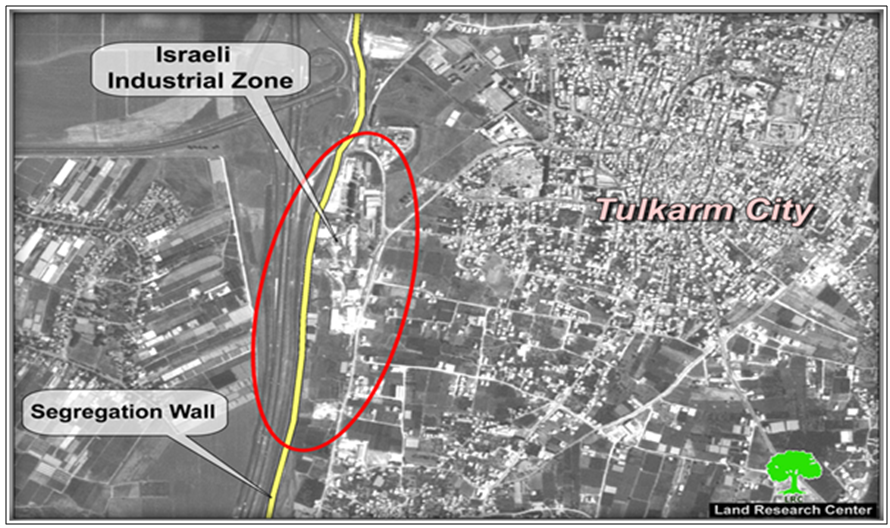 | Figure 2. Airplane image for Gishori industrial zone. Source: [3] |
1.2. Problem Statements
- Soil pollution is defined as the build-up in soils of persistent toxic compounds, chemicals, salts, radioactive materials, or disease causing agents, which have adverse effects on plant growth and animal health [9]. Or an undesirable change in the physical, chemical and biological characteristics of soil, which affect human life, lives of other useful living plants and animals, industrial progress, and living conditions.There is an urgent need to control the soil pollution in order to preserve the soil fertility and increase the productivity of the land near Gishori industrial Complex. About one fifth of the agricultural land in this area is being chemically contaminated. Nearby areas suffer from low productivity, soil being contaminated where its fertility and productivity decreased because of hydrocarbon pollutants, acid rain, and wastewater plants that pour untreated sewage into surrounding agricultural land. The liquid waste from Israeli factories is released freely to the valleys thus lead to leakage of these residues into the groundwater and contaminating the groundwater resources (Al-Khalil, 2009). Inorganic residues in industrial waste cause serious problems as a result of their disposal to the environment. They contain metals which have a high potential for toxicity. Industrial activity also emits large amounts of arsenic fluorides and sulfur dioxide (SO2) [10].
1.3. Sewage and Sludge
- Soil pollution is often caused by the uncontrolled disposal of sewage and other liquid wastes resulting from domestic uses of water, industrial wastes containing a variety of pollutants, agricultural effluents from animal husbandry and drainage of irrigation water and urban runoff [11]. Irrigation with sewage water causes profound changes in the irrigated soils. Amongst various changes that are brought about in the soil as an outlet of sewage irrigation include physical changes like leaching, changes in humus content and porosity, chemical changes like soil reaction, base exchange status, salinity, quantity and availability of nutrients like nitrogen, potassium, phosphorus, etc. Sewage sludge pollutes the soil by accumulating metals like lead, nickel, zinc, cadmium, etc. This may lead to the phytoxicity of plants [12].
1.4. Heavy Metal Pollutants
- Heavy metals are elements having a density greater than five in their elemental form [11]. They mostly find specific absorption sites in the soil where they are retained very strongly either on inorganic or organic colloids. They are widely distributed in the environment, soils, plants, animals and in their tissues. These are essential for plants and animals in trace amounts. Mainly urban and industrial aerosols, combustion of fuels, liquid and solid from animals and human beings, mining wastes and industrial and agricultural chemicals are contributing to the heavy metal pollution. Heavy metals are present in all uncontaminated soils as the result of weathering from their parent materials. In agricultural soils, however, the concentration of one or more of these elements may be significantly increased in several ways, like through applications of chemicals, sewage sludge, farm slurries, etc. Increased doses of fertilizers, pesticides or agricultural chemicals, over a period, add heavy metals to soils which may contaminate them. Concentrations of heavy metals in soils and plants are given in Table 1.
|
1.5. The Objectives of This Research are
- - Study the effect of Gishori Industrial Complex on general land quality in the Tulkarm area, especially in adjacency to the factories. - To assess the heavy metal concentration (B, Ni, Pb, Cu, Cd, Fe, Cr, Mn, Co and Zn) and accumulation on soil that results from different wastes (gas, solid and liquid) of Gishori industrial Complex Study the effect of Gishori industrial Complex on soil pollution and soil deterioration in the study area.
2. Material and Method
- Eight soil samples were collected on July 3, 2015 from different sites within the target area to describe the effect of Gishori Industrial Complex on soil pollution as shown in Figure 3. Each sample consisted of 500 g as a representative sample; it was taken from a soil depth of about 0-20 cm and filled in plastic bottles to evaluate the concentration and accumulation of (B, Ni, Pb, Cu, Cd, Fe, Cr, Mn, Co and Zn) heavy metals.
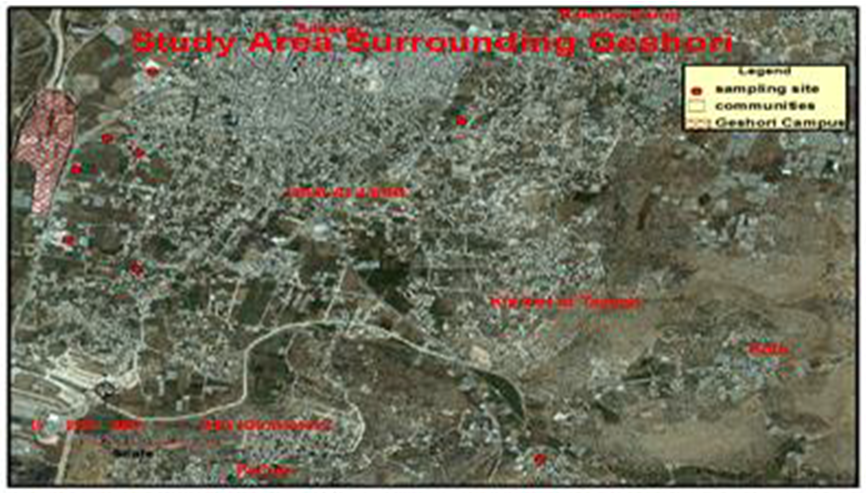 | Figure 3. Soil sampling sites |
3. Result and Discussion
- The results in Table 2. Show the analysis for eight soil samples by ICP method. Different data for the heavy metal concentration and accumulation in the area under study contain are shown:
|
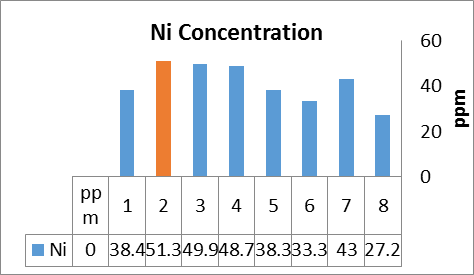 | Figure 4. Nickel (Ni) accumulation for soil samples under study |
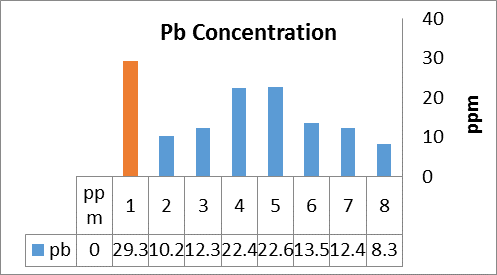 | Figure 5. Lead (Pb) accumulation for soil samples under study |
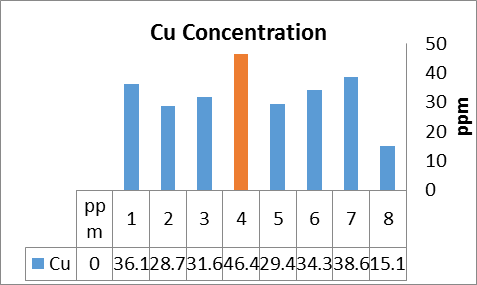 | Figure 6. Copper (Cu) accumulation for soil samples under study |
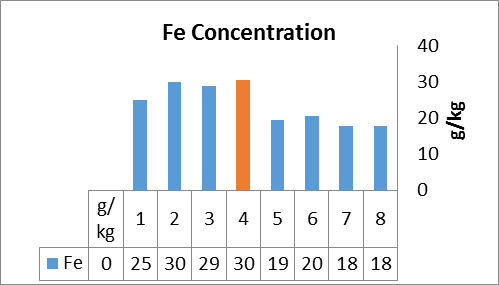 | Figure 7. Iron (Fe) accumulation for soil samples under study |
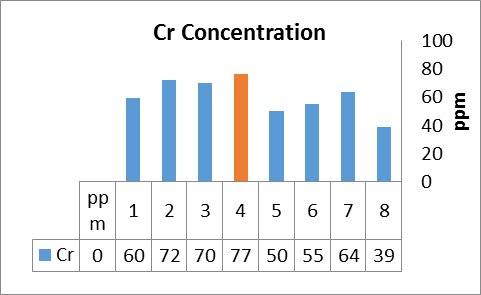 | Figure 8. Chromium (Cr) accumulation for soil samples under study |
 | Figure 9. Manganese (Mn) accumulation for soil samples under study |
 | Figure 10. Cobalt (Co) accumulation for soil samples under study |
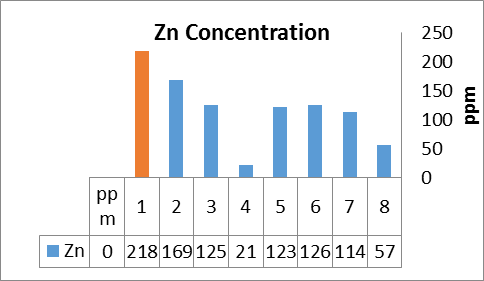 | Figure 11. Zink (Zn) accumulation for soil samples under study |
4. Discussion
- Soils may become contaminated by the accumulation of heavy metals and metalloids through emissions from the rapidly expanding industrial areas, mine tailings, disposal of high metal wastes, leaded gasoline and paints, land application of fertilizers, animal manures, sewage sludge, pesticides, wastewater irrigation, coal combustion residues, spillage of petrochemicals, and atmospheric deposition [14, 15]. Heavy metals constitute an ill-defined group of inorganic chemical hazards, and those most commonly found at contaminated sites are lead (Pb), chromium (Cr), arsenic (As), zinc (Zn), cadmium (Cd), copper (Cu), mercury (Hg), and nickel (Ni) [16]. Soils are the major sink for heavy metals released into the environment by aforementioned anthropogenic activities and unlike organic contaminants which are oxidized to carbon (IV) oxide by microbial action, most metals do not undergo microbial or chemical degradation [17], and their total concentration in soils persists for a long time after their introduction [18]. Changes in their chemical forms (speciation) and bioavailability are, however, possible. The presence of toxic metals in soil can severely inhibit the biodegradation of organic contaminants [19]. Heavy metal contamination of soil may pose risks and hazards to humans and the ecosystem through: direct ingestion or contact with contaminated soil, the food chain, drinking of contaminated ground water, reduction in food quality (safety and marketability) via phytoxicity, reduction in land usability for agricultural production causing food insecurity, and land tenure problems [20-22]. The adequate protection and restoration of soil ecosystems contaminated by heavy metals require their characterization and remediation. Contemporary legislation respecting environmental protection and public health, at both national and international levels, are based on data that characterize chemical properties of environmental phenomena, especially those that reside in our food chain [23]. While soil characterization would provide an insight into heavy metal speciation and bioavailability, attempt at remediation of heavy metal contaminated soils would entail knowledge of the source of contamination, basic chemistry, and environmental and associated health effects (risks) of these heavymetals. Risk assessment is an effective scientific tool which enables decision makers to manage sites so contaminated in a cost-effective manner while preserving public and ecosystem health [24].
5. Conclusions
- According to the results shown in Table 2 and the Figures above, we conclude the following:- B and Cd: both metals were not detected in soil samples collected from the area under study which means that there is no effect by the two heavy metals on the soil or the pollution happening in the target area.- Ni, Pb and Zn in p.p.m (part per million): there is a high accumulation of the three heavy metals in the samples, as shown in measurements 1&2, where concentrations were increased in the land close to Gishori factories; which means that there is a source for pollution that has a direct effect on the soil.- Fe in g/kg: was found to be highly accumulated in the four samples collected from the land close to Gishori factories, whereas the concentrations in the other four samples were decreased the more the distance from Gishori Industrial Complex which means there is a pollution taking place in the area under study.- Cu, Mn, Cr and Co in ppm: there is a high accumulation of the four heavy metals in the samples (values 3&4) and it is more in the samples closer to Gishori Industrial Complex than in the further ones, which means that there is a source for pollution that has a direct effect on soil.- Finally, we conclude that there is a heavy metals accumulation in the area close to Gishori Industrial Complex more than in the farther area. This confirms that there is a heavy metals pollution occurring in the area under study.
6. Recommendations
- According to the results and conclusions mentioned above, were all the analyses and results showed heavy metals accumulation especially in the area closed Gishori factories, the following consideration must be taken into consideration:- Remediation the soil pollutants in area under study by using a friendly Environmental remediation as phytoremediation and bioremediation processes.- Extend and increase advance research in the target area to limit the sources of pollutants.- More monitoring in the threated area from pollutants.
ACKNOWLEDGMENTS
- Thanks are due to the Prof. Dr. Marwan Awartani, President, Palestine Technical University Kadoorie for generous support.
 Abstract
Abstract Reference
Reference Full-Text PDF
Full-Text PDF Full-text HTML
Full-text HTML